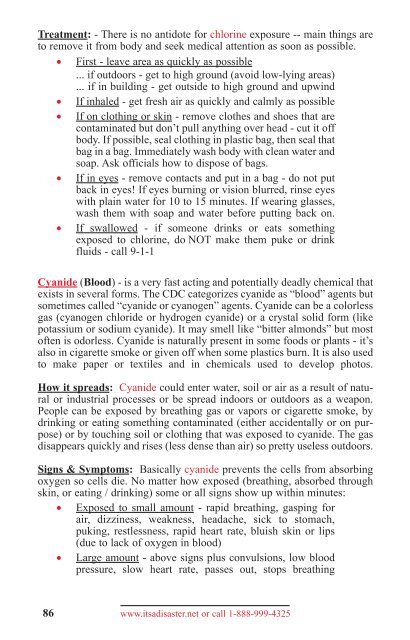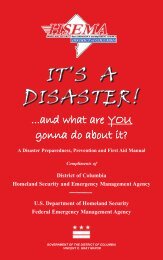disaster 5th 1108_5th ed 2011 - Homeland Security and Emergency ...
disaster 5th 1108_5th ed 2011 - Homeland Security and Emergency ...
disaster 5th 1108_5th ed 2011 - Homeland Security and Emergency ...
Create successful ePaper yourself
Turn your PDF publications into a flip-book with our unique Google optimized e-Paper software.
Treatment: - There is no antidote for chlorine exposure -- main things are<br />
to remove it from body <strong>and</strong> seek m<strong>ed</strong>ical attention as soon as possible.<br />
• First - leave area as quickly as possible<br />
... if outdoors - get to high ground (avoid low-lying areas)<br />
... if in building - get outside to high ground <strong>and</strong> upwind<br />
• If inhal<strong>ed</strong> - get fresh air as quickly <strong>and</strong> calmly as possible<br />
• If on clothing or skin - remove clothes <strong>and</strong> shoes that are<br />
contaminat<strong>ed</strong> but don’t pull anything over head - cut it off<br />
body. If possible, seal clothing in plastic bag, then seal that<br />
bag in a bag. Imm<strong>ed</strong>iately wash body with clean water <strong>and</strong><br />
soap. Ask officials how to dispose of bags.<br />
• If in eyes - remove contacts <strong>and</strong> put in a bag - do not put<br />
back in eyes! If eyes burning or vision blurr<strong>ed</strong>, rinse eyes<br />
with plain water for 10 to 15 minutes. If wearing glasses,<br />
wash them with soap <strong>and</strong> water before putting back on.<br />
• If swallow<strong>ed</strong> - if someone drinks or eats something<br />
expos<strong>ed</strong> to chlorine, do NOT make them puke or drink<br />
fluids - call 9-1-1<br />
Cyanide (Blood) - is a very fast acting <strong>and</strong> potentially deadly chemical that<br />
exists in several forms. The CDC categorizes cyanide as “blood” agents but<br />
sometimes call<strong>ed</strong> “cyanide or cyanogen” agents. Cyanide can be a colorless<br />
gas (cyanogen chloride or hydrogen cyanide) or a crystal solid form (like<br />
potassium or sodium cyanide). It may smell like “bitter almonds” but most<br />
often is odorless. Cyanide is naturally present in some foods or plants - it’s<br />
also in cigarette smoke or given off when some plastics burn. It is also us<strong>ed</strong><br />
to make paper or textiles <strong>and</strong> in chemicals us<strong>ed</strong> to develop photos.<br />
How it spreads: Cyanide could enter water, soil or air as a result of natural<br />
or industrial processes or be spread indoors or outdoors as a weapon.<br />
People can be expos<strong>ed</strong> by breathing gas or vapors or cigarette smoke, by<br />
drinking or eating something contaminat<strong>ed</strong> (either accidentally or on purpose)<br />
or by touching soil or clothing that was expos<strong>ed</strong> to cyanide. The gas<br />
disappears quickly <strong>and</strong> rises (less dense than air) so pretty useless outdoors.<br />
Signs & Symptoms: Basically cyanide prevents the cells from absorbing<br />
oxygen so cells die. No matter how expos<strong>ed</strong> (breathing, absorb<strong>ed</strong> through<br />
skin, or eating / drinking) some or all signs show up within minutes:<br />
• Expos<strong>ed</strong> to small amount - rapid breathing, gasping for<br />
air, dizziness, weakness, headache, sick to stomach,<br />
puking, restlessness, rapid heart rate, bluish skin or lips<br />
(due to lack of oxygen in blood)<br />
• Large amount - above signs plus convulsions, low blood<br />
pressure, slow heart rate, passes out, stops breathing<br />
86 www.itsa<strong>disaster</strong>.net or call 1-888-999-4325





